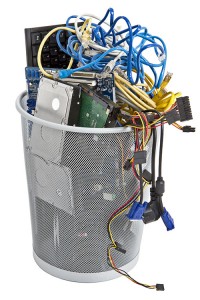 I have seen the future and I am not sure I like it. Recently I wrote about modular electronics and was hopeful we could reduce electronic waste, or e-waste, by retaining smartphones, tablets, and laptops longer and replacing only small broken or outdated components, such as memory or a screen. Although I am still hopeful for the future, I think that we have a long way to go to clean up the waste we have already generated. I was out and about yesterday and came upon a shop propping its door open with a Sony VAIO laptop. If laptops can be used as doorstops, then perhaps we have too many of them on this planet.
I have seen the future and I am not sure I like it. Recently I wrote about modular electronics and was hopeful we could reduce electronic waste, or e-waste, by retaining smartphones, tablets, and laptops longer and replacing only small broken or outdated components, such as memory or a screen. Although I am still hopeful for the future, I think that we have a long way to go to clean up the waste we have already generated. I was out and about yesterday and came upon a shop propping its door open with a Sony VAIO laptop. If laptops can be used as doorstops, then perhaps we have too many of them on this planet.
Current State
According to Earthfix, 1.4 billion new phones are produced each year. Unless they are for new consumers, that means 1.4 billion are also discarded. In a recent article on PBS NewsHour, Jim Puckett, activist and head of the Seattle based Basel Action Network, led an investigation into the electronic recycling industry. Partnering with MIT’s Senseable City Lab, his organization planted tracking devices in 200 pieces of non-functioning electronic waste. They deposited the devices at recognized recycling centers and then followed the trackers to see where they ended up. To their surprise, more than a third of the devices ended up in Asia, most in Hong Kong. Instead of being dismantled and recycled in America, they are being shipped whole to Asia where there are far fewer safety and health regulations. They can be dismantled more cheaply because the methods are crude and dangerous.
While we can pride ourselves on the fact that our electronic waste did not end up in our landfills, we are transferring at least some of the recycling problem to less developed countries. Part of the reason for this is falling steel, gold, plastic, and copper prices. It is more difficult to recoup operating costs for a recycler so they sometimes shift the burden and sell the waste to others who can do it cheaper. What if we didn’t generate all of this electronic waste in the first place?
Future State
I am excited about the possibility of modular electronics and hope they lead to a smaller amount of electronic waste. Europe leads the world in regulations requiring manufacturers to take back and recycle their old products. Despite that diligence, a Newsweek article last year claimed that only one-third of Europe’s e-waste goes where it should and a lot of it ends up in Africa. The United States ships our problem to Asia and Europe ships theirs to Africa. We are both shifting the burden to those less equipped to deal with the problem.
In the U.S., several states have passed laws similar to those in Europe that require manufacturers to create or support outlets that take back end-of-life electronics. While this is a good first step, I think we need to go further. We need to try and find assembly methods that make products easy to disassemble and recycle at the end of the product’s life. While working for Hewlett-Packard a number of years ago, I came up with the idea to manufacture printer shells out of macaroni so that when the printer reaches its end of life, you just pop off the shell, throw it into a pot of water and you have dinner. My idea was not embraced but I still think it is a good one.
Thoughts
Electronic waste and our current recycling methods are a big problem and they are only getting bigger. I would love to hear your thoughts on ways to tackle this. Perhaps together we can come up with a solution.
Kelly Brown is an IT professional and assistant professor of practice for the UO Applied Information Management Master’s Degree Program. He writes about IT and business topics that keep him up at night.


